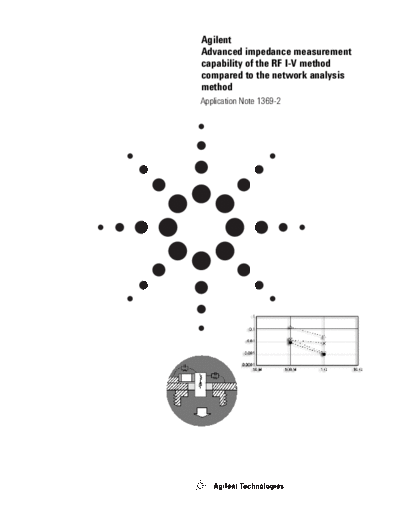Service Manuals, User Guides, Schematic Diagrams or docs for : HP Publikacje 5988-0728EN
<< Back | HomeMost service manuals and schematics are PDF files, so You will need Adobre Acrobat Reader to view : Acrobat Download Some of the files are DjVu format. Readers and resources available here : DjVu Resources
For the compressed files, most common are zip and rar. Please, extract files with Your favorite compression software ( WinZip, WinRAR ... ) before viewing. If a document has multiple parts, You should download all, before extracting.
Good luck. Repair on Your own risk. Make sure You know what You are doing.
Image preview - the first page of the document

>> Download 5988-0728EN documenatation <<
Text preview - extract from the document
Agilent
Advanced impedance measurement
capability of the RF I-V method
compared to the network analysis
method
Application Note 1369-2
1. Introduction
Explosive demand for the method, which is incorporated in Note: This application note treats the
electronic devices used in cellular the current RF impedance analyz- one-port and two-port measurement
phones and high-speed telecom- ers, is an advanced measurement methods for a two-terminal impedance
munication equipment has technique to perform accurate element (device). The transfer imped-
increased the need for impedance ance measurement of a multi-terminal
one-port impedance measure-
circuit network (device with three or
characterization and analysis of ments. In the frequency range up
more terminals) is not treated because
these devices in the RF to to 3 GHz, this method has the it can be made by the two-port meas-
microwave region. In the areas of advantages of higher accuracy and urement method only and is not an
passive device development, pre- a wider impedance measurement application that the impedance
cise RF impedance measurement range than has been achieved analyzers address. The measurement
is vital for the evaluation of real before with other methods. This categories covered by this application
device characteristics and problem product note highlights the RF I-V note are illustrated in figure 2 below:
analysis. In the RF circuit design method and describes differences
environment, RF impedance between the impedance analyzer
measurement also aides high- and the network analyzer to help
performance circuit design by you choose the appropriate meas-
allowing accurate circuit simula- urement method for your intended
tion and selection of appropriate application.
devices for the designed circuit.
Accurate, easy to perform
impedance measurements are
required to evaluate RF character-
istics of generic passive compo-
nents, such as capacitors,
inductors, diodes, PC board pat-
terns etc., because the frequency
dependence of these devices are
not necessarily found in their cat-
alog specifications. Actual imped-
ance characteristics of these
devices will influence the circuit's
operating performance. RF imped-
ance characterization allows the
circuits to be designed using the Figure 1. Typical frequency range of RF impedance measurement methods
device data at the frequencies at
which the devices are actually
used.
There are several techniques to
choose from in making RF imped-
ance measurements, as shown in
figure 1. Each technique has
advantages and disadvantages:
The reflection coefficient, trans-
mission, and S-parameter meas-
urement methods are
conventionally performed with
network analyzers for impedance
analysis in the MHz to GHz region.
Pi () network method is the
standard method for measuring
impedance of quartz crystal
resonators by means of transmis-
sion measurement at frequencies Figure 2. Categories of device types and measurement methods
typically below 300 MHz. The RF I-V
2
2. Measurement application
criteria
In comparing impedance analyzer Measuring a small resistive Required performance to
and network analyzer, this section component separately from a achieve accurate impedance
discusses how their application greater reactive component of characterization
criteria and solutions to measure- impedance requires a high accuracy
ment needs are different from for impedance phase angle. The To achieve accurate measurement
each other. The impedance meas- frequency dependence of device for the small loss factors and para-
urement capabilities required for parameters (C, L, R, |Z|, etc.) is sitics, the following performance
satisfying the device measurement caused by parasitic reactance ele- criteria must be achieved:
needs are also clarified through ments in the device. The lower the
the following discussion. parasitic parameter values are, the 1. Accurate measurements of low
less frequency dependence (flat or D (high Q) and low ESR.
The impedance analyzer basically monotonous characteristics over a 2. A wide impedance measurement
measures two-terminal devices wide frequency range) the device range.
such as capacitors, inductors, has. Therefore, for better frequen- 3. Excellent measurement stability
diodes, resonators, etc.. Measuring cy characteristics of impedance, after calibration.
impedance reveals two key charac- the parasitics of the devices 4. Calibration and compensation
teristics of the devices: loss factor should be minimized as much as functions to eliminate the error
(dissipation factor or Q factor) in possible. The instrument must be sources in the measurement
the required frequency range and able to accurately distinguish even circuit. Specifically, test fixture
the frequency dependence of small differences in the parasitic residuals (residual impedance
device parameters of interest, both parameters. (This is also key fac- and stray admittance) need to
of which result from inner para- tor for the evaluation of dielectric be accurately eliminated.
sitic parameters of the devices. and magnetic materials used in
The dissipation factor (= R/X) rep- electronic devices.) Accurate
resents the relative magnitude of measurement of the parasitics
the parasitic resistance to the enables equivalent circuit parame-
reactance of device. The lower the ters of the devices to be derived.
dissipation factor is, the more ide-
ally reactive the device is.
3
Examples of parasitics in devices
Figure 3 shows an example of Let's examine the required accuracy ESL of 430 pH at ◦ Jabse Service Manual Search 2024 ◦ Jabse Pravopis ◦ onTap.bg ◦ Other service manual resources online : Fixya ◦ eServiceinfo